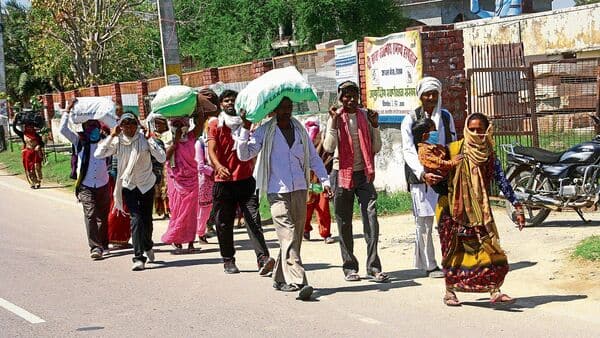The seminal work of Daniel Kahneman and Amos Tversky on Prospect theory discussed the ‘certainty effect’, in which ‘people underweight outcomes that are merely probable relative to outcomes that are achieved with certainty’; “This tendency, called the certainty effect, contributes to risk aversion in choices involving certain gains and to risk-seeking in choices involving certain losses.” Thus, in the absence of certainty, uncertainty , together with information asymmetry, shapes human behavior. Humans are inherently risk averse, so they try to reduce uncertainty because it triggers negative affective responses. Agents try to predict uncertainty based on past knowledge, contextual clues and available information. In the event of an unexpected shock, this becomes difficult and humans tend to become more risk averse. The inherent tendency is then to rely on proven institutions and networks. sudden reverse migration from urban to rural areas during the first phase of the covid pandemic reflects this phenomenon.
The recently released Periodic Labor Force Survey (PLFS) 2020-21 shows that 20.8% of the total male migration in the country was from urban to rural areas in 2020-21. The 2011 census revealed that this proportion was only 8% at the time.
The volume and direction of migration both vary with fluctuations in the economy. Only 6.7% of male migrants attributed their migration to job loss, unit closure or lack of job opportunities. Health uncertainties, lockdowns, temporary closure of units, stores and establishments, coupled with the absence of a safety net in some cases, may have been the driving force behind this reverse migration. The PLFS lists 16 reasons for migration and the absence of a safety net is not one of them. One of the reasons could be the difficulty in determining what a safety net is. To the credit of the Ministry of Statistics, health-related issues and housing issues are on the list.
The 2020-21 economic study offered a bare necessities index. Access to housing, water, sanitation, electricity and clean cooking fuel has improved significantly in recent years, thanks to Union and state government programs. In its calculations, the Ministry of Statistics could rely on this index of what is strictly necessary to define a safety net.
Government policies create safety nets for those who need them, but when people migrate, they often miss out on the benefits of geography. A prerequisite for any policy intervention in favor of migrants is to identify who the migrants are. In 1979, India enacted its Interstate Migrant Workers (Regulation of Employment and Conditions of Service) Act, which contains provisions for the registration of interstate migrants. This law lists, among other things, the duties and obligations of an entrepreneur. The law directs this entity “to provide, in respect of any interstate migrant worker who ceases to be employed, a return…to the specified authority in the state from which he is recruited and in the state in which he is employed, which must include a statement that all wages and other dues payable to the worker and the price of the return trip to his state have been paid”. This has never happened. The work of Implementation of the law rests with the Indian states.As indicated by several studies, however, most states do not enforce this law.
Some states have safety net provisions, but there are issues with the dissemination of information, which must be directed to the appropriate beneficiaries. This brings up the question of who the migrants are.
In a federal system, due to a lack of effort from the States, the Union government has initiated the process of portability of access to what is strictly necessary. This has several advantages. First, in the short term, it helps the Center create a safety net for individuals, especially migrants, in the absence of enactment of laws by states. Second, it allows individuals to take risks; a safety net makes it possible to migrate elsewhere for better economic opportunities without worrying about failure. Third, it allows individuals to retain the same social security benefits across the country.
Programs like One Nation, One Ration Card and Ayushman Bharat have helped ensure Indians have largely uniform access to food and health care. However, in these two schemes, it is necessary to correct the errors – in particular of exclusion – which accumulate against the poor.
In addition, urban housing for migrants remains a major concern. The proliferation of slums in Tier 1 and Tier 2 cities is proof of this. Recently, the Union government has attempted to address this problem by introducing affordable rental housing complexes, a sub-scheme of the urban Pradhan Mantri Awas Yojana. However, for the successful implementation of such programs, it again becomes necessary to identify migrants.
Therefore, States should work with the Center to reduce uncertainty for migrant workers. Although basic necessities can be a starting point, the portability of benefits should not be limited to them. Their contours should be broadened to dimensions such as access to education. Only then can we ensure the surefire inclusion of migrants.
Aditya Sinha & Mr. Suresh Babu are, respectively, Additional Private Secretary (Research) and Advisor, Economic Advisory Council to the Prime Minister
Catch all the trade news, market news, breaking news and latest updates on Live Mint. Download the Mint News app to get daily market updates.
More less

